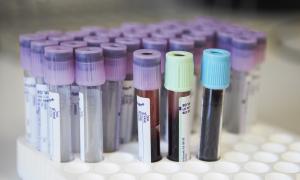IrsiCaixa designs an open access protocol for the detection of SARS-CoV-2 antibodies without using commercial kits

The protocol, focused on the detection of antibodies against two regions of the Spike viral protein, is available to all laboratories and research centers
The SARS-CoV-2 pandemic is causing a worldwide lack of supply of commercial kits to determine the presence of antibodies against the new coronavirus, used to determine whether an individual has been exposed to the virus. For this reason, IrsiCaixa has designed a protocol for a very common laboratory technique called ELISA that enables the analysis of antibodies without using commercial kits. The new protocol detects antibodies against two different regions of a viral protein called Spike. Nearly any of the commercial kits focus on these regions, but researchers have demonstrated that they provide more reliable results. The protocol has been published today so that everyone has access to it. The test is not approved as a diagnostic method, but it can be used for research.
Antibodies are produced by the immune system to fight against pathogens. Therefore, if a person has antibodies against certain virus, it means that there is an infection and the immune system is reacting against it, or that the infection has already passed and antibodies stay as a reminder of the immune activity.
The easiest way to detect these proteins are the so-called “rapid serological tests” or the ELISA (short for “Enzyme-Linked ImmunoSorbent Assay”). ELISAs are generally more sensitive than rapid tests. “It is a simple procedure that can be performed in almost any research center or diagnostic laboratory," explains Jorge Carrillo, senior researcher at IrsiCaixa who set up the protocol. “But currently the commercial kits are not supplied because of the high demand. The centers have the capacity to do the test, but they lack the "raw material". That is why we have designed an ELISA using reagents used for research, which also need to be purchased but are much easier to obtain,” he continues.
The protocol is already available for laboratories, research centers and any institution with the capacity to carry out an ELISA. The test takes approximately 2 hours, once the device is ready. “It is imperative to make sure that research can be carried out in all the centers. We are one of the first in Spain, if not the first, to have an initiative like this,” says the director of IrsiCaixa, Bonaventura Clotet.
Sensitivity and specificity
The researchers first analyzed the immune response against different areas of the SARS-CoV-2 Spike protein –the S1 subdomain, the S2 and the Receptor Binding Domain (RBD)– and against the nucleocapsid. According to Carrillo, “the ideal situation is a test with high sensitivity, which is the ability to detect positive cases, and high specificity, which is the probability that there are no false positive cases". ELISA tests allow the detection of smaller amounts of antibodies than rapid tests and also do it in a very specific way, which means that they present greater sensitivity and specificity.
By statistical analysis of data, researchers determined that the best antigens to differentiate the seropositive and seronegative population for SARS-CoV-2 are the S2 and RBD regions of the Spike protein. "Among those that we analyzed, these are the ones generating less false positive cases and less false negative results, so the protocol uses both," Carrillo explains.
Current kits focus mostly on the nucleocapsid, S1, or RBD, while S2 is almost unexploited. Not all the kits specify the proteins used for the analysis, adding value to data provided by IrsiCaixa.
Research use
The protocol is not approved as a diagnostic method. "Diagnostic tests require specific quality controls and homologation processes, but the results are perfectly useful in the context of research," says Carrillo.
Part of this work has been financed thanks to the funds raised through the #YoMeCorono initiative. "At this time, it is essential to do research without any obstacle, neither financial nor the supply of materials. With this protocol we are providing a crucial tool so that all centers can work. The more we can advance, the sooner we will finish the race against the virus ”, Clotet concludes.